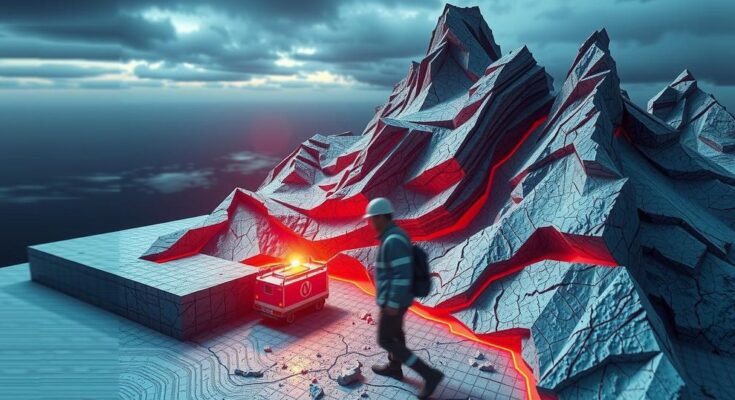Recent breakthroughs in artificial intelligence have demonstrated the potential for accurate earthquake prediction. In 2023, researchers at the University of Texas developed an AI system called DiTing, capable of forecasting up to 70% of earthquakes within a week. Additionally, work at Los Alamos National Laboratory has successfully identified subtle earthquake precursors, enhancing the understanding of fault behaviors. These advancements signify a revolutionary shift towards proactive disaster preparedness, leveraging technology for improved seismic monitoring and safety.
For decades, researchers have faced significant challenges in accurately predicting earthquakes, often perceiving it as an insurmountable challenge. The unpredictable and severe nature of earthquakes has rendered traditional prediction methods largely ineffective, exacerbating humanity’s vulnerability to their destructive consequences. However, recent advancements in artificial intelligence (AI) have begun to shift this narrative, offering promising developments in the field of earthquake forecasting.
In 2023, a remarkable breakthrough occurred at the University of Texas at Austin’s Jackson School of Geosciences, where a team developed an AI system capable of forecasting approximately 70% of earthquakes up to a week in advance. This system, named DiTing, was trained using five years of seismic data from China. By analyzing seismic activity patterns, the algorithm identified potential epicenters and evaluated the probabilities of impending earthquakes. During a seven-month evaluation period, DiTing demonstrated exceptional precision by successfully predicting 14 earthquakes within a 200-mile radius of their epicenters.
Sergey Fomel, a geoscientist involved in the research, remarked, “Predicting earthquakes is the holy grail. We’re not yet close to making predictions for anywhere in the world, but what we achieved tells us that what we thought was an impossible problem is solvable in principle.”
Further advancements have been made at Los Alamos National Laboratory, where researchers have utilized machine learning techniques to detect subtle precursors to earthquakes. These signals, which had previously been masked by seismic noise, were successfully identified at the Kīlauea volcano in Hawaii, marking a significant achievement in understanding fault behaviors. Lead researcher Christopher Johnson explained, “We wanted to see if we could pull out signals from the noise and identify where the system was nearing a major slip in the loading cycle.”
The implications of these AI advancements extend far beyond merely predicting seismic events. Modern AI systems now provide real-time insights that can significantly enhance disaster preparedness by giving communities crucial lead time for evacuation or the implementation of protective measures. As AI technologies like DiTing continue to evolve, there is an unprecedented opportunity for enhancing global seismic monitoring capabilities.
DiTing’s capabilities, supported by data from the China Earthquake Observation Network, illustrate how the integration of extensive datasets and advanced technology can lead to improved earthquake detection accuracy and response efficiency. These technological innovations represent not only a significant triumph in the field but also a crucial step toward protecting lives and diminishing the destruction caused by earthquakes.
While challenges in earthquake prediction persist, the promising advancements made by AI researchers signal a future where the unpredictable nature of earthquakes may become more manageable, allowing for better preparedness against natural disasters. The ongoing endeavors at renowned institutions such as the University of Texas at Austin and Los Alamos National Laboratory highlight the transformative potential of AI in this field. By effectively harnessing AI, humanity stands on the brink of a paradigm shift in its approach to natural disasters, moving from mere reactive responses to proactive resilience. In conclusion, the dawn of AI-driven earthquake prediction heralds a revolutionary change in safeguarding communities against these formidable forces of nature.
The ability to accurately predict earthquakes has long been a pursuit for scientists, primarily due to the devastating consequences these natural disasters pose to life and infrastructure. Traditional prediction methods have relied on historical seismic data or geological indicators, often resulting in imprecise forecasts. However, emerging technologies like artificial intelligence are beginning to redefine this field, leveraging vast datasets and sophisticated algorithms to enhance predictive capabilities and improve real-time monitoring systems. With ongoing research and development, the potential for effective earthquake prediction is becoming increasingly attainable.
The advancements in artificial intelligence, particularly through the work of researchers at esteemed institutions, represent a significant move toward reliable earthquake prediction. As AI systems like DiTing and machine learning techniques become more sophisticated, they pave the way for enhanced disaster preparedness and community resilience. While the challenges in this field remain, the strides made indicate a promising future in earthquake forecasting, where humanity can better safeguard itself from the impacts of natural disasters.
Original Source: indiaai.gov.in




